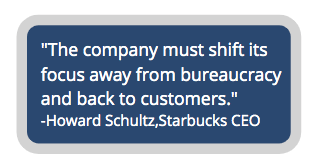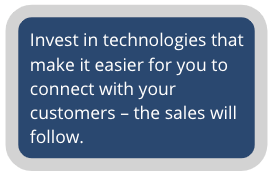Customer Experience During Times Of Crisis (Part 2)
By Jeff Oskin, Jolt Consulting Group

This is the final article of a series from Jolt Consulting Group of how companies can survive and even thrive during the COVID-19 era by focusing on improving their customer experience. Click here for Part One.
Why Customer Experience Matters
Bain and Company analyzed past recessions and the link to customer experience…their findings were interesting.[1] The losing companies tended to follow a few recession dead ends with extreme cost-cutting, strayed outside their core business, or acted too late. The strongest companies coming out of the last recession went on offense early and they focused principally on improving the customer experience, simplifying and personalizing it through investments in digital capabilities. Starbucks is just one case study of a company that excelled in challenging times.
Starbucks
 During the 2007 recession, Starbucks was forced to close some 600 stores and saw profits decline 30 percent. On January 8, 2008, Howard Schultz, the founder, returned as CEO of Starbucks and shot off a letter to the employees on the day he took office and said, "The company must shift its focus away from bureaucracy and back to customers.”[2] He made his objective very clear, to be successful, Starbucks needed to "reignite the emotional attachment with customers.” To address his concerns, Schultz outlined and implemented a three-pronged program:
During the 2007 recession, Starbucks was forced to close some 600 stores and saw profits decline 30 percent. On January 8, 2008, Howard Schultz, the founder, returned as CEO of Starbucks and shot off a letter to the employees on the day he took office and said, "The company must shift its focus away from bureaucracy and back to customers.”[2] He made his objective very clear, to be successful, Starbucks needed to "reignite the emotional attachment with customers.” To address his concerns, Schultz outlined and implemented a three-pronged program:
 Improving Customer Experience – "My Starbucks Idea" was rolled out for customers to exchange ideas with each other and directly with the company generating ideas from 1.3 million users. By giving customers a platform to voice their ideas and views on the brand and by responding to it, it was able to reignite the brand trust.
Improving Customer Experience – "My Starbucks Idea" was rolled out for customers to exchange ideas with each other and directly with the company generating ideas from 1.3 million users. By giving customers a platform to voice their ideas and views on the brand and by responding to it, it was able to reignite the brand trust.
Technology – Well before its competitors, Starbucks embraced technological advances to help make it easier for customers to conduct business with them, for example, Starbucks was one of the first that embraced mobile applications.
Employee Engagement – Employees (including baristas) were always an integral part of Starbucks online and the social media community. Starbucks has a separate web page for its employees, which is used to generate and debate ideas.
Actions To Take Now
Jolt Consulting Group believes there are three fundamental actions a company can take now to improve its customer experience and, in turn, position it for accelerated growth and market share capture once the difficult times pass. The recommendations focus on three of the assets present in any organization – its employees, its processes, and its technology.
Employee Engagement (People)
James K. Harter, Ph.D., Gallup's Chief Scientist of Workplace Management stated, "In bad times, employee engagement is the difference between surviving and not. In good times and bad, low employee engagement reduces performance, customer satisfaction, and profit.”[3]
Organizations with more than four engaged employees for every one actively disengaged employee saw 2.6 times more growth in earnings per share than did organizations with a ratio of slightly less than one engaged worker for every one actively disengaged employee.[4] And earnings per share for top-quartile (in engagement) organizations outpaced the earnings per share of bottom-quartile companies by 18 percent.
There are several concrete actions a leader can take to improve employee engagement.
- Share with employees what you expect from them.
- Make sure employees have the right materials and equipment to do their jobs.
- Allow people to do what they do best.
- Don't forget to give recognition or praise.
- Let your employees know you care about them.
- Keep encouraging their development.
Assess Your Actions From The Customers Vantage Point (Process)
Too often businesses fail to think through their internal actions (processes) from the vantage point of their customer. We encourage our ’clients’ leaders to stop looking inward on their business with their back to the window and instead, turn the chair around and look outside. Understand what it is like to be on the outside interacting with your organization.
There are several actions that leaders can take that can help think through your processes from a customer’s vantage point:
- Reject the old paradigms that treat a contact center as nothing more than a cost center. Your contact center is your main window into your customers’ minds and frustrations.
- Demand ownership of the customer experience. Do you have a defined customer experience process? Does your entire team know how you want your customers treated?
- Listen to your customers as you create your strategy. Especially in times of crisis, customers will tell you what’s important, but only if you listen.
- Conduct a gap analysis of your customer journey offering and then implement best practices to address those gaps. Do your offerings align with what your customer has said is important?
- Evaluate software with customer experience as the top goal for a business case. Technology should never drive the business or its processes, but it is a critical component of any organization as it provides needed channels to ensure customers can access your organization when and how they want.
Make Strategic Investments (Technology)
 Historically, investments in sales and marketing technologies have been prioritized during periods of contraction, with the thought during lean times being “we need to grow sales.” Unfortunately, this mindset is the very epitome of ‘inward’ thinking referenced earlier. Instead, invest in technologies that make it easier for you to connect with your customers – the sales will follow. Prime areas for investment would include your contact center, service organization, and post-sale account management teams.
Historically, investments in sales and marketing technologies have been prioritized during periods of contraction, with the thought during lean times being “we need to grow sales.” Unfortunately, this mindset is the very epitome of ‘inward’ thinking referenced earlier. Instead, invest in technologies that make it easier for you to connect with your customers – the sales will follow. Prime areas for investment would include your contact center, service organization, and post-sale account management teams.
As a leader, there are some specific areas you can explore for investment, each of which would positively impact your customers’ experience. Those areas are:
- Digital Tools to Improve Communication (Engage)
- Customer portals, chats, online social-networking communities, etc.
- Productivity Focused Investments (Increase Efficiency)
- Field service scheduling & dispatch tools, mobile technologies, and remote monitoring technologies.
- Customer Data & Analytics (Deepen Relationships)
- Operational performance data (the basics – how are you performing for them?)
- Customer asset data (the “gold”) – performance data on equipment/assets you manage for them.
- Outcome-centric data (how are they better because of you?).
Conclusions
As history has shown, retreating into a shell or trying to cut our way out is a recipe for failure in the long run. Only those organizations that effectively balance prudent cost savings and strategic investments, especially in their customer experience, will capture market share over the long-term. Focusing on ways to improve your employee engagement, streamline processes and invest in technology, all through the lens of your customers, will allow you to outflank competitors who simply try to “ride it out.” View the current crisis as an opportunity and we firmly believe that you will emerge a stronger, more profitable, and larger firm as a result.
For more information, visit www.joltconsultinggroup.com for a whitepaper on this topic.
About The Author
Jeff Oskin is the President of Jolt Consulting Group LLC. He is an expert understanding business visions and translating those visions into concrete action plans that organizations can execute. He has proven countless times throughout his 20+ year career an ability to be a savvy executive who understands the nuances of optimizing business operations, managing change, acquiring technology, and managing large-scale programs/projects.
